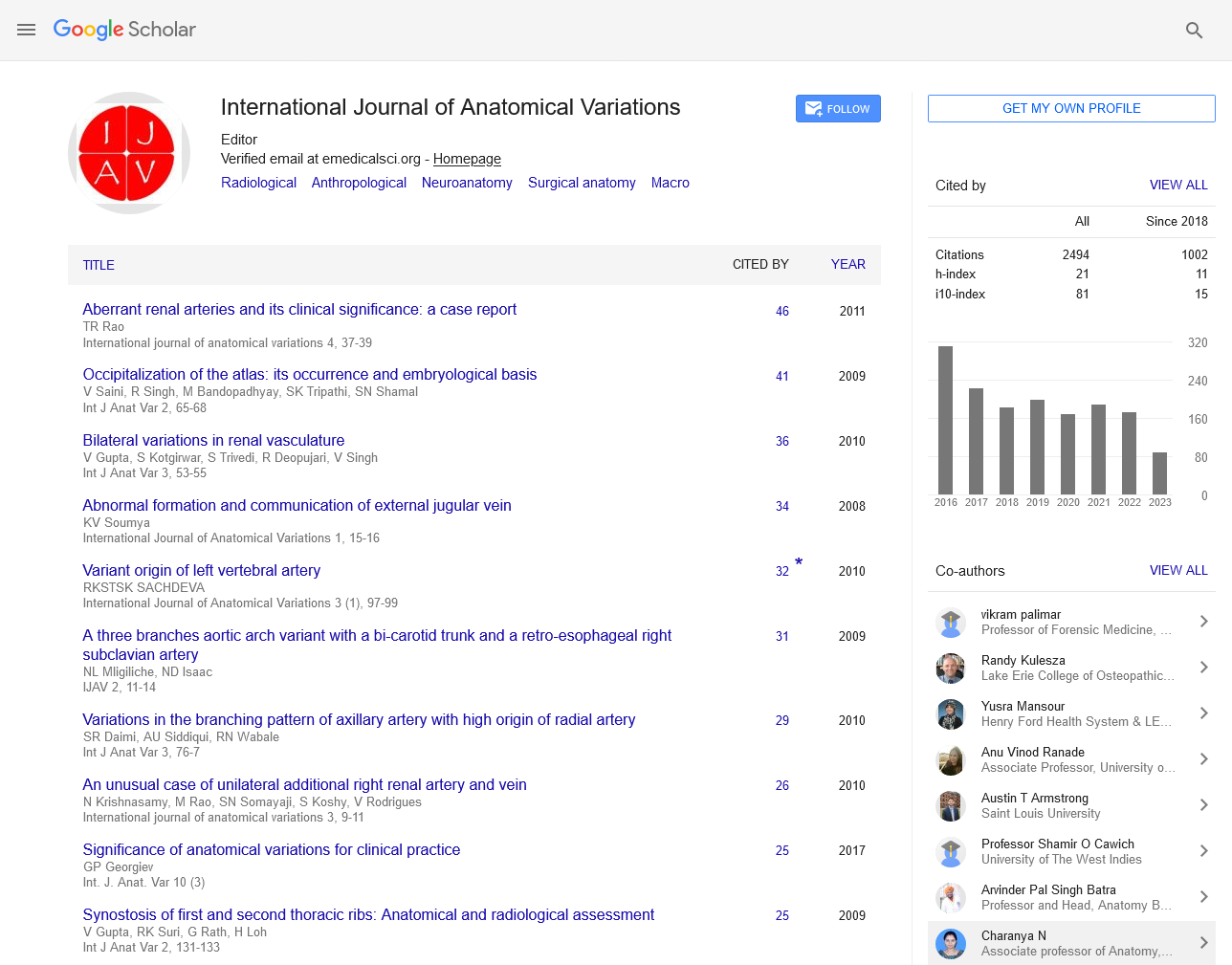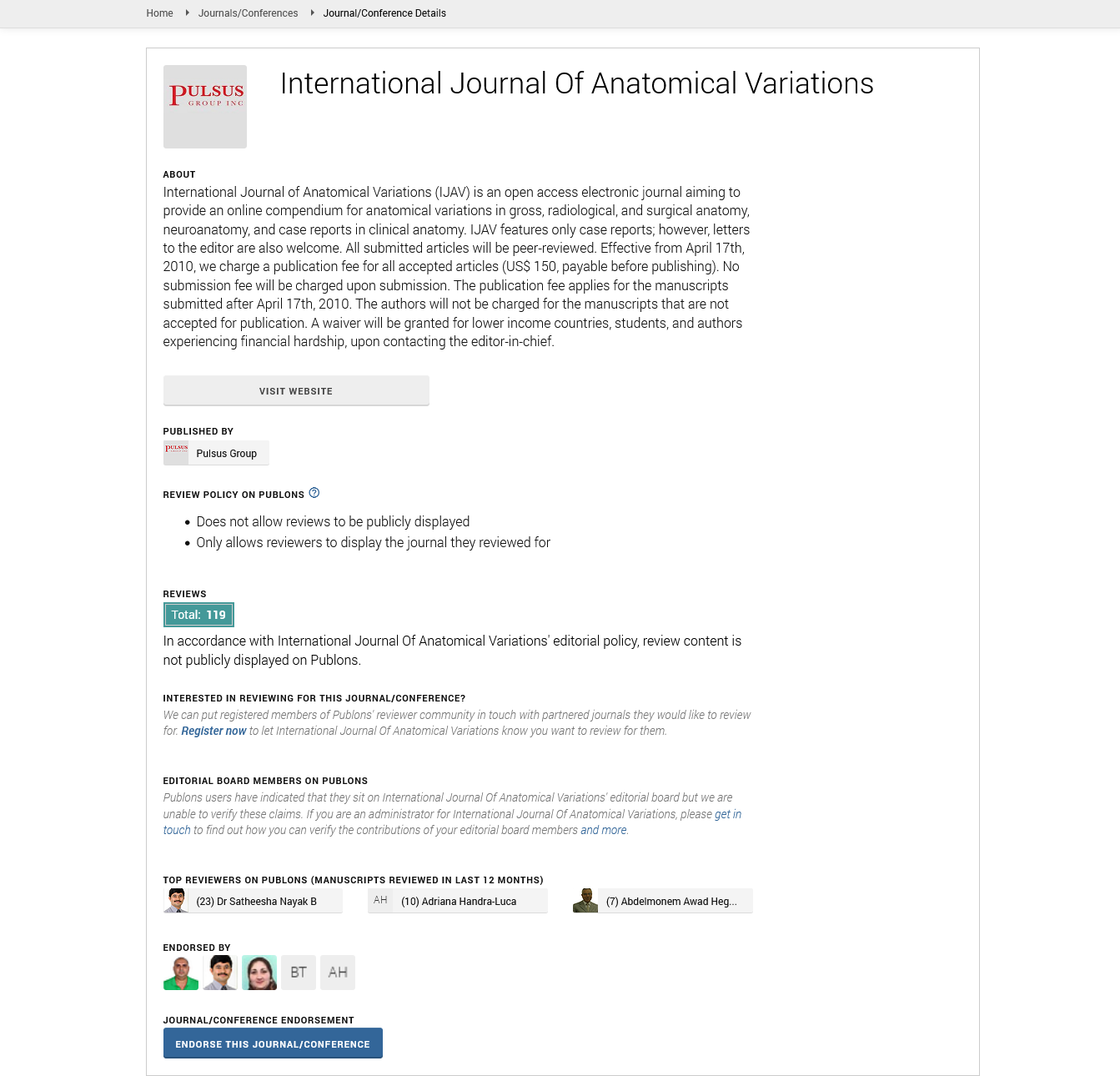Morphological Variations Origins Types and Significance in Biological and Clinical Contexts
Received: 01-Feb-2025, Manuscript No. ijav-25-7618; Editor assigned: 04-Feb-2025, Pre QC No. ijav-25-7618 (PQ); Reviewed: 19-Feb-2025 QC No. ijav-25-7618; Revised: 26-Feb-2025, Manuscript No. ijav-25-7618 (R); Published: 28-Feb-2025, DOI: 10.37532/1308-4038.18(2).482
Citation: Singh A. Morphological Variations Origins Types and Significance in Biological and Clinical Contexts. Int J Anat Var. 2025;18(2): 733-734.
This open-access article is distributed under the terms of the Creative Commons Attribution Non-Commercial License (CC BY-NC) (http://creativecommons.org/licenses/by-nc/4.0/), which permits reuse, distribution and reproduction of the article, provided that the original work is properly cited and the reuse is restricted to noncommercial purposes. For commercial reuse, contact reprints@pulsus.com
Abstract
Morphological variations are inherent differences in the form and structure of organisms, particularly within a species. These variations can occur due to genetic, developmental, environmental, and evolutionary factors. In human biology and medicine, understanding morphological variations is crucial for accurate diagnosis, surgical planning, forensic identification, and anthropological studies. This article provides a comprehensive overview of morphological variations, categorizes their types, examines their biological origins, and highlights their significance in both clinical and research settings.
INTRODUCTION
Morphology, the study of the form and structure of organisms, lies at the heart of both biological sciences and clinical practice. While a “standard” anatomical model provides a baseline for understanding the human body, real-life observations consistently reveal differences known as morphological variations that reflect the diversity of life [1]. These variations, ranging from subtle differences in bone structure to significant deviations in organ size or location, are not only common but also vital for adapting to various environmental and genetic contexts. In human health, morphological variations can present both opportunities and challenges. On one hand, they enrich our understanding of human adaptability and evolution; on the other, they can complicate clinical procedures if not properly recognized. This article explores the nature and types of morphological variations, their underlying causes, and their practical importance in medicine, anthropology, and related disciplines. Morphology, the study of form and structure in living organisms, provides vital insights into both the diversity of life and the functional adaptations that support survival and reproduction. Within a single species, especially humans, observable differences in physical form—known as morphological variations—are not only common but biologically significant. These variations can involve differences in bone structure, muscle configuration, vascular patterns, dental arrangement, and numerous other anatomical features [2]. The origins of morphological variation are multifactorial, arising from genetic diversity, developmental pathways, environmental influences, and evolutionary pressures. While some of these variations are subtle and clinically inconsequential, others can have profound implications for health, disease susceptibility, surgical risk, and even identity determination in forensic contexts. Understanding such differences is therefore not only central to evolutionary biology and anthropology but also crucial in clinical disciplines such as radiology, surgery, dentistry, orthopedics, and personalized medicine. As medical practice increasingly shifts toward individualized approaches, the recognition and interpretation of morphological variations are becoming more important than ever. This paper explores the biological origins of morphological variation, categorizes its most common forms, and highlights its relevance in both research and clinical settings [3].
ORIGINS AND CAUSES OF MORPHOLOGICAL VARIATIONS
Genetic polymorphisms and mutations are primary drivers of morphological differences. Variations in developmental genes, such as those in the HOX gene family, influence the size, shape, and segmentation of body parts. Inherited traits may result in variations like polydactyly (extra digits) or dental arch differences. Embryological processes are highly complex and sensitive to perturbations. Minor deviations during fetal development can lead to structural differences, such as variations in muscle insertions, vascular patterns, or skeletal formations. Congenital anomalies are extreme forms of such deviations [4].
ENVIRONMENTAL FACTORS
External factors such as nutrition, physical activity, disease, and lifestyle can influence morphology. For example, prolonged mechanical load on bones can result in thicker cortices, while malnutrition during growth periods can lead to stunted stature.
EVOLUTIONARY AND POPULATION-LEVEL ADAPTATIONS
Morphological traits often exhibit regional patterns that reflect evolutionary pressures. For instance, populations in colder climates tend to have shorter, stockier builds for heat retention (Allen’s rule), while those in warmer regions may exhibit leaner physiques.
CLINICAL AND FUNCTIONAL SIGNIFICANCE
Unrecognized morphological differences can lead to surgical complications. For example, variant hepatic or biliary ducts may be inadvertently damaged during laparoscopic procedures [5].
RADIOLOGICAL INTERPRETATION
Radiologists must distinguish between normal variants and pathological findings. Misinterpreting a normal bone variant as a tumor or fracture can lead to unnecessary interventions.
FORENSIC AND ANTHROPOLOGICAL APPLICATIONS
Morphological markers help in sex determination, ancestry estimation, and identification in forensic science. They are also crucial in evolutionary studies for reconstructing human migration and adaptation patterns.
PERSONALIZED MEDICINE
Understanding individual anatomical and morphological traits is essential for customizing prosthetics, implants, and pharmacological treatments, especially in orthopedic and dental fields.
EDUCATIONAL AND RESEARCH IMPLICATIONS
Medical and anatomical education must integrate awareness of morphological variability. Teaching "normal ranges" instead of rigid norms fosters more adaptable and observant clinicians. In research, cataloging variations aids in refining biomechanical models, improving diagnostics, and deepening understanding of evolutionary processes.
CONCLUSION
Morphological variations are a testament to the biological diversity and adaptability of humans and other organisms. They are not merely academic curiosities but hold profound implications across medical, forensic, evolutionary, and anthropological domains. As science advances toward more personalized and precise practices, recognizing and understanding these variations becomes increasingly essential. Incorporating this awareness into education, clinical care, and research ensures a more inclusive and accurate approach to human biology.
REFERENCES
- Fekadu M (1988) Pathogenesis of rabies virus infection in dogs. Rev Infect Dis 10:678-683.
- Fekadu M, Shaddock JH, Baer GM (1982) Excretion of rabies virus in the saliva of dogs. J Infect Dis 145:715-719.
- Knobel DL, Cleaveland S, Coleman P G, Fèvre EM, Meltzer MI et al. (2005) Re-evaluating the burden of rabies in Africa and Asia. Bull World Health Organ 83:360-368.
- Lembo T, Attlan M, Herve B, Cleveland S, Costa P et al. (2011) Renewed global partnerships and redesigned roadmaps for rabies prevention and control. Vet Med Int 1-18.
- Deressa A, Ali A, Beyene M, Newayeselassie B, Yimer E (2010) The status of rabies in Ethiopia: A retrospective record review. Ethiop J Health Dev 24:127–132.
Indexed at, Google Scholar, Crossref
Indexed at, Google Scholar, Crossref
Indexed at, Google Scholar, Crossref






